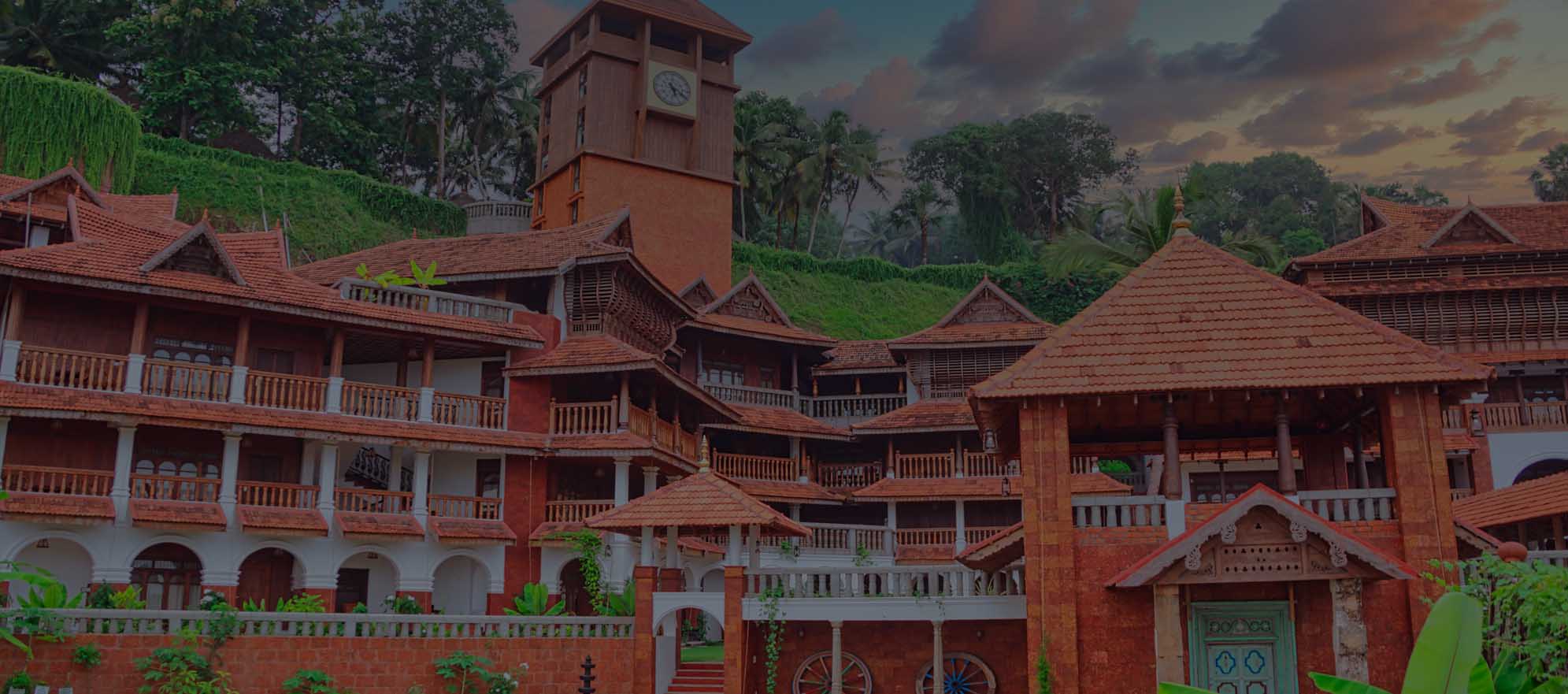

ESCAPE TO SOMATHEERAM AYURVEDA VILLAGE IN KERALA
There’s a Chinese lady sitting at lunch slavered in a red face pack. Fabric is wound around her crown, like bandages, and she’s wearing a green overall and sipping fresh pineapple juice. Nearby a Russian man wanders around the garden sporting banana, egg white and mango painted on his face. He has also just enjoyed a Thalapothichil treatment, in which the head is covered with herbal paste and topped off with a lotus leaf — a procedure that’s said to be good for depression and stress.
I’m at the Somatheeram Ayurveda Village — India’s first Ayurvedic hospital in a resort setting. Opened 35 years ago, it boasts more awards than I’ve had hot curries (a lot, in other words). It’s situated in Thiruvananthapuram, Kerala, above a golden beach that extends to eternity and beyond — and where groups of fishermen gather to untangle their Himalayan-size fishing nets.
The luxury at Somatheeram comes not from swanky accommodation: the cottages and rooms are simple although there are must-have antiques around the resort, such as stone Indian goddesses and ancient cauldrons once used for mixing Ayurvedic concoctions. The real luxury it offers, though, is its first-rate Ayurvedic hospital, 15 Ayurvedic doctors (mine, Dr. K. Chandrasekharan Nair, is excellent) and 71 experienced therapists in a resort setting.
In other words, it’s for those who like their Ayurveda with a bit of buzz. For people who want more than just yoga, meditation and treatments: who want OM plus something a little more happening. And who don’t want the traditional approach to Ayurveda which discourages strenuous exercise and spending time in the sun during the course of treatments. This means that Somatheeram works as well for families and for those just wanting to chill, as for those wishing simply to focus on treatments.
The retreat is perched on a verdant hill dotted with coconut palms — the sweet, tender fruit from the trees providing post-treatment drinks for guests. It’s a wheelchair ramp or 60 steps from the bottom of the hill (and my cottage) to the hospital’s therapy rooms: a walk that meanders through 15 acres of garden with medicinal herbs and mango, jackfruit and tamarind trees, with the sea breeze on my face, and the sound of hymns coming from the beachside church below and mingling in the balmy air with the caw caw of crows.
Time now to go up to the Ayurvedic hospital. It’s here that therapists wear hairnets and face masks (disposable ones for hygiene purposes, rather than for beautifying their complexions). A lady in a white overall and with a plait to her waist, Dr. Reshma Venu, the ‘medical officer,’ leads me to a consultation room
She gives me a 17-page booklet to fill in – encompassing questions on my sex life, eating habits to whether I’m happily married and how long I’ve practised yoga. ‘Is your stress related to personal life, marriage or other?’ it asks. ‘Are you an optimist or pessimist?’ ‘Do you speak softly/ normal/ loudly?’ All this helps the doctors identify my dosha, or body type. “A doctor will diagnose a patient’s constitution by everything from the way she walks, talks, her behaviour and by taking her pulse,” Dr. Venu reveals.
The big chief medical doctor, Dr. K. Chandrasekharan Nair, comes in. Age 71, he has been an Ayurvedic doctor for 50 years. A man with a kind face, he wears sapphire and peridot rings. He explains Ayurveda to me. It means, he says, science of life. The theory is that the living and non-living are made of air, space, water, fire and earth — present in the body and mind in Vatha, Pitha and Kapha: the three bio energies.
“Vatha is air and space, and it helps with internal and external movement — from running to the beating of the heart or going to the lavatory,” says Dr. Nair. “Pitha is fire….digestion is its main function, plus hormones and body temperature. Kapha is water and earth….and helps with growth, development and immunity and frame of body and structure. Someone’s constitution or basic nature never changes.” He offers a very detailed and attentive consultation and then decides on my individualised treatment plan to get my doshas into balance.
There are all sorts of treatments available. From Abhyangam — a synchronised medicated oil massage with two therapists, and good for skin and circulation — to Kizhi pouch message with medicinal herbs or rice, and milk or medicated powder, and good for pain and joint stiffness of joints. From Kativasthi — in which the therapists pour warm oil onto the crown in a ring made of black gram powder paste, good for spinal and neck pain, to a Pizhichil medicated oil bath and Sirovasthy in which oil is poured onto the crown through a leather funnel to relax the mind. Not to forget Karnapooram – ear fumigation using anti-bacterial smoke from medicated herbs, and also Akshitarpanam – an eye treatment good for helping vision.
My favourite therapy is the foot massage, a deep tissue massage in which I lie on the floor while Prasanna hangs expertly over me, holding onto a rope and massaging me with a foot so adept it should be playing the piano. The dry powder massage — in which I’m scrubbed and massaged with handfuls of hot herbs like fine sand — is a dead cert for getting rid of cellulite and for sending me to the land of bliss. My all-out fave, though, is Shirodhara – in which warm oil in a pot dangled above my head is gently moved back and forth by the therapist, the oil dribbling hypnotically onto my forehead.
It would be possible to spend a month or two or three doing little other than having great treatments here. (Top tip: bag therapists Prasanna and Swathy D.). But most guests go for a week to 21 days, and reap benefits. Is there anything I don’t like? Hmmm. Nasyam, perhaps, in which oil in dripped into the nostrils with a gokarna pot….but it’s good for the sinuses. And the consultation timings are sometimes a bit off: but this is India, not Switzerland.
And what of the accommodation and facilities? There are 80 thatched Keralan cottages and bedrooms at Somatheeram — built of mud and bricks, with reed ceilings, fans or air-conditioning (the chilliness of air conditioning is not recommended during a course of Ayurveda) and beds swathed with mozzie-net canopies. (Insider tip: book a sea-view cottage).
There’s a swimming pool that overlooks the Arabian Sea. Plus an al fresco performance space for everything from Kathakali classical dance performances — the dance troupe boasting ankle bracelets and adept hand movements — to sitar recitals during dinner
There’s also a yoga shala with its sides open to the ocean — for asanas (postures) practised to the sound of crashing waves — and another yoga hall atop the hill, this one with pictures of chakras and charts explaining astral bodies and a meditative flame flickering in a brass temple candle holder. It’s here that I join daily group meditation and excellent yoga, and also have private lessons with the super flexible, beautiful and very inspiring Jinu JR, a lady with a smile the size of the sun, clad all in white and able to bend seemingly beyond the body’s limits.
That’s enough of the OM factor then. Let’s talk retail therapy. Well, there are three little shops: jewellery stores flogging yellow topaz, Burmese rubies, diamonds (with certification) and ones selling (real) pashminas of teal, lavender and mustard colours. And a naturopathic pharmacy with everything from ‘hair drop-out cream’ to Masala tea and herbal powder.
When I’m not lying on my back having treatments, mostly I’m eating. There’s a big buffet for every meal — one of those ones that takes around five minutes to walk end-to-end while gawping — with dishes marked according to the dosha for which it’s good; or it’s possible to order individualised dishes a la carte, although that can involve a 30-minute wait. There’s also an Ayurveda dietician sitting in the dining hall to guide guests on what to eat.
Breakfast is everything from bread rolls and omelette to tropical fruits and iddli (fluffy steamed rice cakes), appam (rice hoppers leavened with fermented palm sap and served with vegetable stew). All washed down with Ayurvedic teas or fresh ginger, lime and honey. Lunch or dinner might be a thali (a range of south Indian vegetarian dishes), vegetable soup made of herbal leaves, beetroot soup, onion throran (onion fried with grated coconut), black dal, lemon rice and curries such as pavacka thoran or bitter gourd with coconut sauce.
The food is 90% organic, and there’s no alcohol permitted and no tobacco. There are sometimes naughty Italians to be found standing outside smoking by gate. But who am I to judge while I’m wandering around wearing egg white and sandalwood powder on my face?